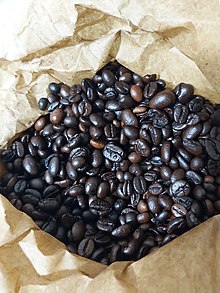Sagada coffee
| Sagada coffee | |
|---|---|
 Coffee beans from Sagada province | |
| Species | Coffea arabica |
| Origin | Sagada, Cordillera, the Philippines |
Sagada coffee, also known as Sagada arabica, is a single-origin coffee varietal grown in Sagada in the Cordillera highlands of the northern Philippines. It belongs to the species Coffea arabica, of the Typica variety.
History
Arabica coffee was introduced to Sagada in the late 19th century. Relatively later in comparison to lowland coffee varietals which were introduced to the Philippines earlier during the Spanish colonial period. This was because Sagada only became recognized as a political unit by the Spanish colonial government in 1847 and didn't have much contact with the Spanish prior to that.[1]
There are multiple conflicting accounts of when and how arabica coffee was introduced to Sagada. Most accounts credit Jaime P. Masferré, a retired Spanish soldier originally from Catalonia. He was a former detachment commander of the Guardia Civil. He married Mercedes Cunyap Langkew, a Sagada native, and established a plantation in the late 1890s in the town of Batalao after the Spanish Empire surrendered the Philippines to the United States colonial government. He grew citrus trees, mabolo persimmon, chayote, and arabica coffee (probably from Benguet) which supposedly later became part of the crops of the local communities.[2][1] His son, Eduardo Masferré also became notable in his own right and is regarded as the "father of Philippine photography."[3][4]
The coffee trees were also said to have been spread to the northern areas of Sagada by Okoi, a Japanese immigrant and a carpenter who worked for the American missionaries in the village of Fidelisan. He acquired coffee seedlings through his friendship with Masferré and planted them in Fidelisan.[2]
Cultivation
Sagada coffee production is centered in the municipalities of Sagada and Besao in Mountain Province, northern Luzon. Like Benguet, the climate of the Cordillera highlands of Sagada is highly suitable for arabica cultivation.[5] Production is mostly in backyard and small-scale farms of the Sagada natives since the early 1900s. In Fidelisan, there are century-old coffee trees that still produce beans.[6][2]
Most were for local consumption, though they bartered surplus beans to traveling traders from the lowlands. They also used coffee beans to barter for goods from local merchants. Cultivating and harvesting Sagada coffee were traditionally women's activities, often involving the entire community.[6][2] Sagada coffee is characterized by its bittersweet taste with fruity or floral overtones.[7][8][9]
Sagada coffee is rare, even in local markets, because there have never been large-scale plantations of Sagada coffee until recently.[6][10] There are increasing government initiatives to encourage its production in recent years, including providing training and equipment. In Sagada, there is a municipal ordinance that requires every household to plant at least five Sagada coffee trees. Before granting a marriage license, the local Sagada government also requires couples to plant the same number of trees.[5][11] However the industry still struggles because of lack of awareness and low local demand.[12]
See also
References
- ^ a b Anacio, Danesto B. (2016). "Sustainable Development Goals (SDGs) in Perspective: Lessons from the American Episcopal Missions in Sagada, Northern Philippines". In Servaes, Jan (ed.). Sustainable Development Goals in the Asian Context. Springer. p. 73. ISBN 9789811028151.
- ^ a b c d Malanes, Maurice; Nakamura, Midori; Tacloy, John (October 10, 2016). "History of Coffee in the Cordillera". Kapi Tako. Retrieved December 19, 2018.
- ^ Aguilar-Cariño, Maria Luisa B. (1994). "Eduardo Masferré and the Philippine Cordillera". Philippine Studies. 42 (3): 336–351. JSTOR 42633450.
- ^ Masferré, Eduardo (1999). A Tribute to the Philippine Cordillera. Asiatype, Inc. p. 2. ISBN 9789719171201.
- ^ a b "Mt. Province coffee backed". BusinessWorld. January 12, 2012. Retrieved December 20, 2018.
- ^ a b c Verne, La. "From Bean to Brew". Tayo Literary Magazine.
- ^ "Sagada Dark Roast Cold Brew + Figures Of Beans". The Peach Kitchen. August 2017. Retrieved December 20, 2018.
- ^ Emocling, Oliver (November 9, 2017). "Kris Aquino should drink these on her coffee date". Nolisoli. Retrieved December 20, 2018.
- ^ Co, Ailene (March 19, 2018). "Seattle's Best Coffee Offers World-Class Beans From Sagada, Benguet, and Matumtum". Trend Hotspot. Retrieved December 20, 2018.
- ^ Del Mundo, Ida Anita Q. (February 10, 2008). "A brewing revolution". PhilStar Global. Retrieved December 20, 2018.
- ^ Tibaldo, Art (2014). "Brewing and Understanding Coffee Inside and Out". Agriculture Monthly. No. November. Retrieved December 20, 2018.
- ^ Co-Calleja, Alina R. (January 26, 2017). "I've 'bean' to Sagada...via a coffee lab in QC". GMA News Online. Retrieved December 20, 2018.
- Articles with short description
- Short description matches Wikidata
- Use mdy dates from October 2022
- Use Philippine English from October 2022
- All Wikipedia articles written in Philippine English
- Articles with 'species' microformats
- Flora of the Philippines
- Coffee varieties
- Hot drinks
- Non-alcoholic drinks
- Filipino cuisine
- Coffee in the Philippines
